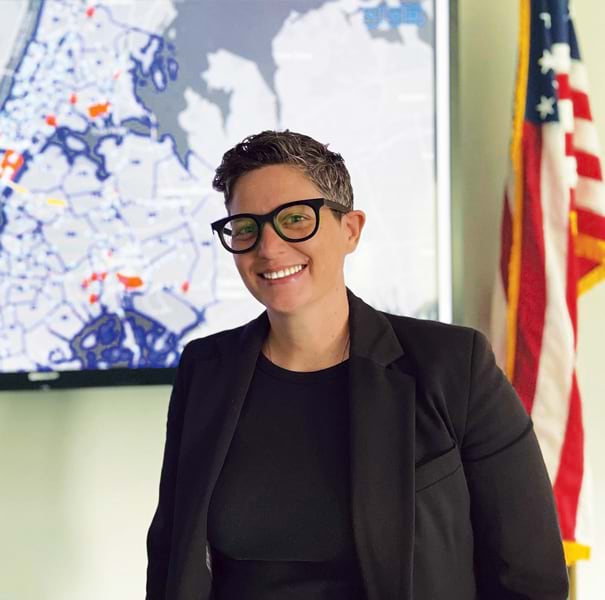“I love GIS. I’m passionate about it,” said Hayley Gerkman, intelligence research specialist for the New York Police Department’s (NYPD) Intelligence and Counterterrorism Bureau. “I just want people to use it and love it as much as I do because I know how effective it is.”
Throughout her career, Gerkman has been a change agent for GIS by building relationships and trust with colleagues and showing them how the technology—and geointelligence in general—can enhance their work. She understands the importance of using the geographic approach to solve critical and urgent problems. And she makes bold moves to achieve her goals.
“She’s in a division at the NYPD—counterterrorism and intelligence—that’s naturally isolated, and she’s a woman and a civilian. Yet she’s gone in there and demonstrated with hands-on technology in real-life situations why the geographic approach and ArcGIS technology can really move the needle not only in intelligence but also across the NYPD,” said Dave LaShell, Esri’s account manager for the NYPD. “It’s a really forward-thinking way for the NYPD to operate.”
“She doesn’t just sling apps for presentations either,” echoed Nadine Hughes, program manager for the NYPD’s Esri Advantage Program. “She provides an easier way for people across the organization to access the GIS data and technology they need. That’s a real leadership move.”
Gerkman says she was into maps as a kid growing up in Colorado. So when she entered the University of Colorado to study geography and sociology with emphases in GIS, cartography, and criminology, it was no surprise that she liked mapping technology.
“It was partially because someone lied to me and told me I’d make, like, $100,000 straight out of college in 2003,” she joked. “But really, I just fell in love with it.”
After college, Gerkman took a job as a digital imagery analyst at Space Imaging (which was later bought out by DigitalGlobe, now known as Esri partner Maxar). She stitched together imagery from the India Remote Sensing satellite system, verifying the images’ accuracy.
“There weren’t too many commercial satellite companies at the time, so this was kind of an up-and-coming thing,” Gerkman said.
She found it intriguing to work with imagery and believes that this experience helped her advance her career later on. But she missed using GIS, so her next position was as a GIS technician at Premier Data Services, Inc. Taking land parcel records kept on microfiche, she developed a GIS model of the Bureau of Land Management’s land grid in several states. She also did a stint as a geospatial analyst for engineering consulting firm Michael Baker International, where she helped map the national pipeline system for the Department of Homeland Security.

From there, Gerkman landed a job as a geospatial intelligence analyst at the National Geospatial-Intelligence Agency (NGA). She was initially assigned to the Levant team, which covers Syria, Lebanon, and Israel. She liked the work, especially since she was one of the few GIS analysts among imagery specialists. But she’d always wanted to be in law enforcement. So when a position detailed to the Federal Bureau of Investigation (FBI) soon opened up within the NGA, Gerkman went for it—despite the position being one or two pay bands above her level at the time. She got it.
“The FBI had just started its journey into GIS, so we were supporting their efforts as they stood up their GIS program,” Gerkman said.
She worked on a smaller team that was doing regional intelligence. When her supervisory special agent received a promotion, Gerkman followed her to the counterterrorism unit.
“That was very cool,” Gerkman said. “I got to work on a bunch of terrorism cases and did a lot of [collaborative] work.”
Her supervisory special agent was promoted again, so Gerkman accompanied her to the FBI’s Washington Field Office.
“They had just set up a [GIS] team, and there were a couple of analysts who were really eager to use the technology,” Gerkman remembered. “We all worked together to try to build up the Washington Field Office’s group. It was wonderful.”
After spending six years in Washington, DC, however, Gerkman became restless and wanted to move.
“On a whim, I was able to get a 30-day tour-of-duty change,” she said. This sent her to New York City. “I just said, ‘I’ve got 30 days to convince them that I need to stay up here.’ And in 30 days, I convinced them that the New York Field Office really needed me.”
Until Gerkman got to the FBI’s New York Field Office, the team had never really used GIS or geospatial intelligence (GEOINT).
“Intelligence is already complicated, but in New York, I always had to think outside the box and say, ‘How can GEOINT enhance all these investigations?’” she mused. “Because they weren’t familiar with GIS, I was constantly marketing it and coming up with creative ways to show agents how it would enhance their cases and be the technology they never knew they needed.”
According to LaShell, that’s what Gerkman excels at.
“She doesn’t overwhelm people with tech,” he said. “She always knows which person to go to and builds a relationship with them before bringing forward the relevant technology. She goes to the right people with the right idea all the time.”
After six years in New York, the NGA tried to call Gerkman back to Washington, DC. But she and her wife had built a life in Brooklyn, where they’d started raising two sons. They wanted to stay. Gerkman contacted a former colleague to see if the NYPD had any openings in intelligence. The agency did. Thus began a new journey.
“When I came in, I was shocked to find out that the NYPD had just set up a contract with Esri. I wondered how they did GIS before,” Gerkman recalled. “So I was an intelligence analyst working cases, but I also started showing them the ways of GIS. Just like at the FBI, it’s an uphill battle because I have to show every single person a way that GIS can help them. And how can I reach 55,000 people—and 30,000 police officers—with the one-woman show I’m running? There’s so much capability, and there are so many different use cases.”
But she’s doing it. Gerkman often shows up to important briefings with leaders up and down the NYPD chain of command with visual aids she’s built using ArcGIS StoryMaps that show the evolution of a situation or an event—complete with photos, videos, and interactive maps. One project that this was particularly effective for was an initiative to clean up graffiti around the city.
“Law Enforcement Explorers, who are kids that participate in an NYPD program for them, go to sites that the community has labeled as graffiti-filled and clean them up,” Gerkman explained. “The commissioner wanted me to map out everything so each precinct could identify where they wanted the kids to go paint. As these groups were going out and painting and posting about it on social media, we were live-updating the public-facing map. You could see the progress and click on a point and see the before-and-after photos. It was so successful. I believe it was the first time we’d ever done anything like that.”
Developing proof-of-concept projects like this can really elevate GIS within an organization, according to Gerkman. She advises current and aspiring geospatial leaders to be strong communicators who can get their points across quickly and effectively.
“That helps people get excited about GIS, and then you can start leading them toward using it more often,” she said. “Now that people at the NYPD are more aware of what GIS is, it’s easier for them to incorporate it into their everyday work and analytical projects.”
Gerkman recently became a certified trainer through the State of New York and is building the first GEOINT course for the NYPD. She hopes this can help expose more people to the powers of GIS and empower them to use it themselves.
“Maybe I’ll be out of a job soon,” she quipped.

